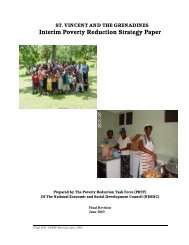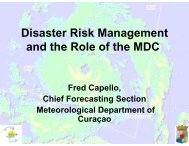The Anatomy of A Silent Crisis The Anatomy of A Silent Crisis
The Anatomy of A Silent Crisis The Anatomy of A Silent Crisis
The Anatomy of A Silent Crisis The Anatomy of A Silent Crisis
- TAGS
- anatomy
- www.bb.undp.org
Create successful ePaper yourself
Turn your PDF publications into a flip-book with our unique Google optimized e-Paper software.
92 Forum 2009: Climate Change – <strong>The</strong> <strong>Anatomy</strong> <strong>of</strong> a <strong>Silent</strong> <strong>Crisis</strong><br />
<strong>The</strong> A2 IPCC climate scenario was used for estimation. <strong>The</strong> A2 scenario is one <strong>of</strong> the more<br />
aggressive scenarios described in the model. <strong>The</strong> A2 storyline and scenario family describes a very<br />
heterogeneous world. <strong>The</strong> underlying theme is self-reliance and preservation <strong>of</strong> local identities.<br />
Fertility patterns across regions converge very slowly, which results in continuously increasing<br />
population. Economic development is primarily regionally oriented and per capita economic growth<br />
and technological change more fragmented and slower than other storylines. Temperature increase<br />
in the period 2090-2099 vs. 1980-1999 is assumed between 2 to 5.4 degrees Celsius with a likely<br />
value <strong>of</strong> 3.4 and sea level rise 0.23-0.51m.<br />
Resulting “economic cost” estimates used in Human Impact Report<br />
Economic losses (from<br />
economic and noneconomic<br />
sectors)<br />
Social cost <strong>of</strong> carbon<br />
Reduced growth rate<br />
Result 2010 – Mean Result 2030 – Mean Comment<br />
125.8 billion USD 340.8 billion USD Note that the PAGE 2002<br />
(90% confidence interval:<br />
model does not give a<br />
4.1, 951.1)<br />
value for 2030 (value<br />
extrapolated from 2020)<br />
1.350 billion USD Not calculated Note that the model<br />
(300, 3450)<br />
output is the cost per<br />
tonne (this cost applied<br />
2004 emissions level)<br />
0.23 percent <strong>of</strong> global 0.43 percent <strong>of</strong> global Note that the PAGE 2002<br />
GDP (90% confidence GDP<br />
model does not give a<br />
interval: 0.007, 1.73)<br />
value for 2030 (indication<br />
is average <strong>of</strong> 2020 and<br />
2040 results)<br />
Estimate <strong>of</strong> impact on poverty used in Human Impact Report<br />
According to World Bank 2005 statistics, roughly 2.6 billion people live on less than $2 per day.<br />
Stern ‘Economics <strong>of</strong> Climate Change’, 44 indicates that experts have suggested a 2 percent poverty<br />
reduction for a 1 percent increase in GDP. Using this relationship, we assume that a 0.23 percent<br />
loss <strong>of</strong> global GDP results in a 0.46 percent increase in poverty that could otherwise have been<br />
averted. <strong>The</strong> same approach is used to estimate the value for 2030 with the additional assumption<br />
that the overall number <strong>of</strong> poor people stays constant.







